I’ve always been interested in enlightenment, or higher consciousness, or, put simply, getting high. But, by now I find it easier just to be high, instead of having to get high.
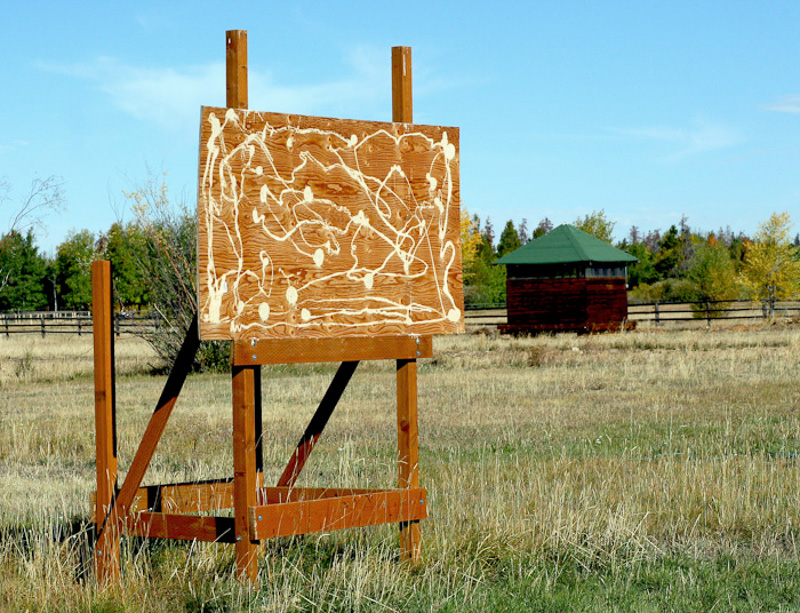
So how to stay high? There are no instructions. But for a starting point, why not assume that you already are high all the time—you just have to notice.
I mean, come on. We’re in a cloud of an octillion atoms that are waves in a Hilbert space of quantum foam. and we evolved from slime or something, and now we build hive cities and ride in machines? And you’re gonna tell me you’re not high?

It’s helps me to be high if I pay close attention to the now. Slalom past the remorse/yearning for the past or fear/longing for the future. Stare and hearken as if you were zonked.
Here we are. What’s up?

Well…right now, we seem to be crows. And it’s a miracle that anything exists at all. The endless roar of reality’s crashing wave. The air like clear jelly. We’re soaring over it.
Lacking a full-bore technorama physical wonder scene like this, I try to stay high by finding gnarl and chaos in my immediate surroundings. Piecing them together.

Is there a difference between gnarl and chaos? Not that much. It’s like noun versus verb. Generally chaos is applied to an ongoing process, a dynamical system, like the weather or a life or a double-jointed pendulum.
Gnarl, on the other hand, can refer to something static. Like the gnarly root of a redwood, or a grain of wood, or the shape of a wave (as opposed to its motion).
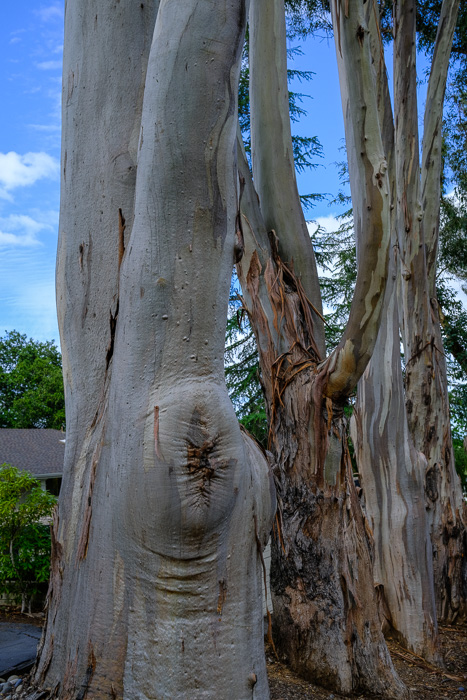
A chaotic system makes gnarly patterns. And if you want to try and generate a gnarly pattern, your process is going to be chaotic. So the two concepts are quite close.
The way that leaves and branches move in air currents is always a buzz-generator, how they never repeat, and yet are somewhat regular. There’s a mathematical reason for this.
Leaves and branches, if you break them down, can be visualized as made up of linked pendulums…like little pendulums attached to bigger pendulums and yet smaller pendulums dangling off the tip-ass end of the little pendulums. And linked, or compound, pendulums are always chaotic.
They used to sell these things for “executive toys” to put on desks. You’ve probably seen them.
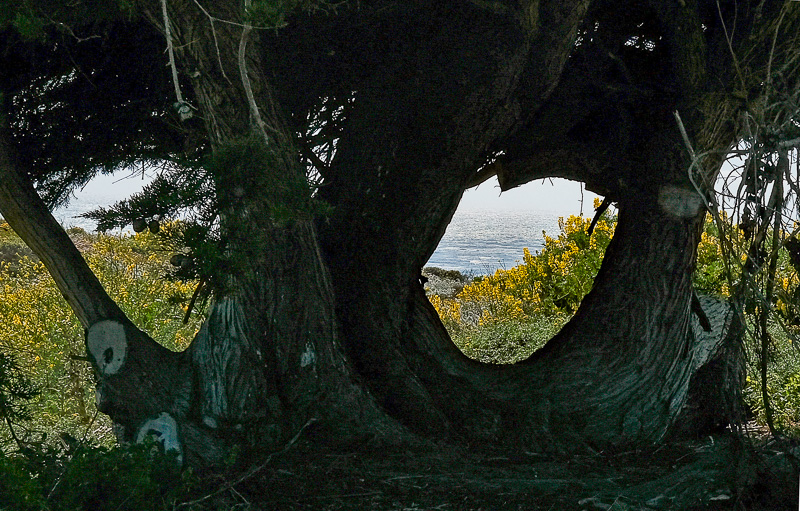
Chaotic processes are unpredictable, but they aren’t exactly random. They wander around in the so-called phase space of all the possible configurations that the system might get into. But a chaotic process doesn’t visit every single one of its possible configurations. This becasue, once again, it’s not random. It hangs out on a certain set of behaviors that it “likes.” And this subset of the phase space is what’s called a chaotic attractor. The process dances around on its attractor in an unpredictable way
I’m not making this up. There’s a whole branch of science called chaos theory…it’s inspired by physics, biology, and chemistry, and it’s formulated in terms of math.

Chaos and gnarl lie in the zone between order and disorder.
If something repeats, it’s boring, dead, a waste of time. You know those little robo-music snippets they play in commercials these days, the same snippet over and over, nudge-nudge-nudge. The effin’ worst. Nowhere near chaos.
At the other extreme, you can get into a complete random scumble of dots, and that’s dull too. The crackle of radio hiss. Nothing happening there. Deep space telephone off the hook.
In between is gnarl and chaos. Life is chaos. Nature is gnarly. And so is good music! The vibrations and overtones of voices. The predictable yet ever-fresh progress through time. Surging on that chaotic dynamical system. Yah mon!
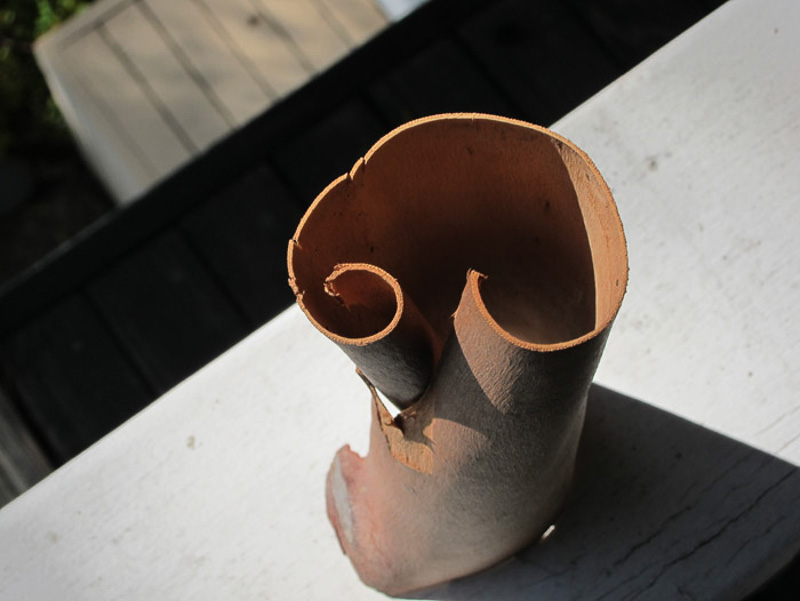
Chaos is the zone we live in: not precisely repeating, and not completely smeared out scuzz. It’s a catchy, heartening tune in between, a beautiful work of art.
That shape of bark you see above, it’s called a Zhabotinsky scroll, and you find it all over the place. Embryos, eddies in the water, tissues in your body, chemical reactions, air turbulence and even, I would hazard, the workings of your mind.
The Zhabo scroll is a good symbol of chaos. It’s a common strange attractor, that is, lots of complex processes converge on that shape.

When my grandchildren visit, we like to throw buckets of water in the air, and I marvel at the insanely rapid physical computations performed by the mass of liquid.
The other day, I crushed my shutter speed down to 1/4,000 of a second, and behold. Turns out the water makes a shape like the bill of a sawfish—I’m talking about the regularity of form in those scallops along the edge.
And for seventy years, I never noticed that. It happens too fast.
The scallops are a fine example of what we chaoticians call a strange attractor—which is, once again, a shape or behavior that a gnarly natural system tends to end up in.

Ocean waves are a really clear example of chaotic attractors. The spume, the rivulets, the giraffe-hide patches of foam.
Hydrodynamic chaos one reason I love to go to the beach, or to the Santa Cruz bluffs overlooking the sea. I go there to think about chaos. To gloat over the utter unpredictability of the detailed motions of water.

At home I can see it in our wading pool. Note the scalloped edge of splash sheet, the ribs in the sheet, the droplets that subdivide into smaller droplets.
Chaos is about the fusion of (a) unpredictability and (b) sameness. The hydrodynamic attractors are forms we see in the ocean and in our wading pools and our shower stalls and sink faucets…these attractors, these types of behavior are well known and we have names for them. Ripple, tube, splash, surf, wave, droplet, etc.

There’s another aspect of strange attractors. An irregular and chaotic undulation in water is really a pattern in space and time; a four-dimensional shape, if you will. But you can see interesting things by focusing on a lower-dimensional aspect of the process. Such as the 2D image of blobs of light reflected off the water’s surface.
We say we’re studying a “Poincare section,” of a chaotic system if we crush it down to a lower-dimensional projection.

Late in the 19th century, the mathematician Henri Poincare was trying to solve the “three body problem” of analyzing the full range of dynamical behavior that can occur when three bodies in space are orbiting each other…think of a planet and two large moons. These systems get into intricate chaotic behaviors.
If we think in terms of the positions and velocities of all three objects at once, with time thrown in, we’re talking about a so-called phase space with nineteen dimensions. Like I’m saying, Poincare proposed focusing on a lower dimensional “slice” of the full higher-dimensional pattern. The Poincare section.
With those three moving bodies, you might just graph the points where the objects pass through some randomly chosen reference plane. And you’d get an accumulating dust of points that sketches a lower-dimensional strange attractor.

I like to look at weird “caustic” reflection lines from light hitting a curved surface like my car, and moving on a wall. If the car isn’t moving, this isn’t really a chaotic dynamical system. It’s a static gnarly design. Kind of a Poincare section of the car’s shape.
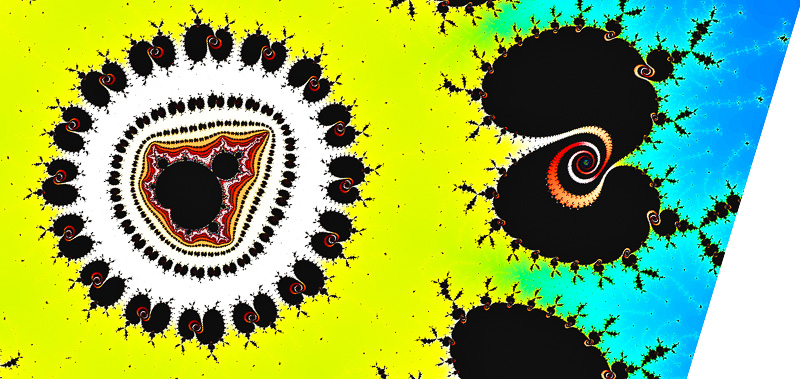
I used to spend a lot of time designing computer simulations to create gnarly fractals. This is, like, a fifth-order Mandelbrot set. See my page on this jive.
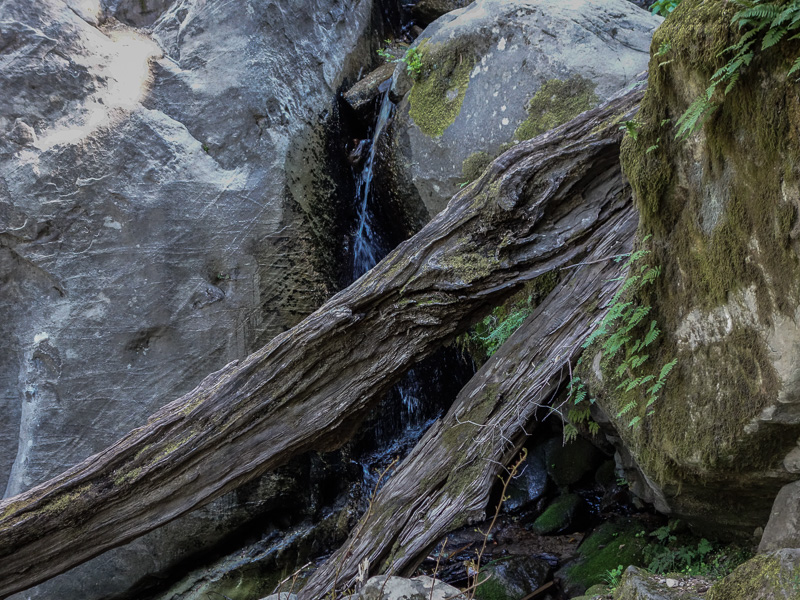
I like to gloat over the massive CG crunch that goes into the lights and shadows and highlights in the visual field.

And I dig the freewheeling synch of external sounds with my thoughts and the things I see. When I remember to kind of slam on the mental synchronicity-perceiving connection-mode.
And spinning out this kind of happy-talk about gnarl and chaos…it gets me even higher.
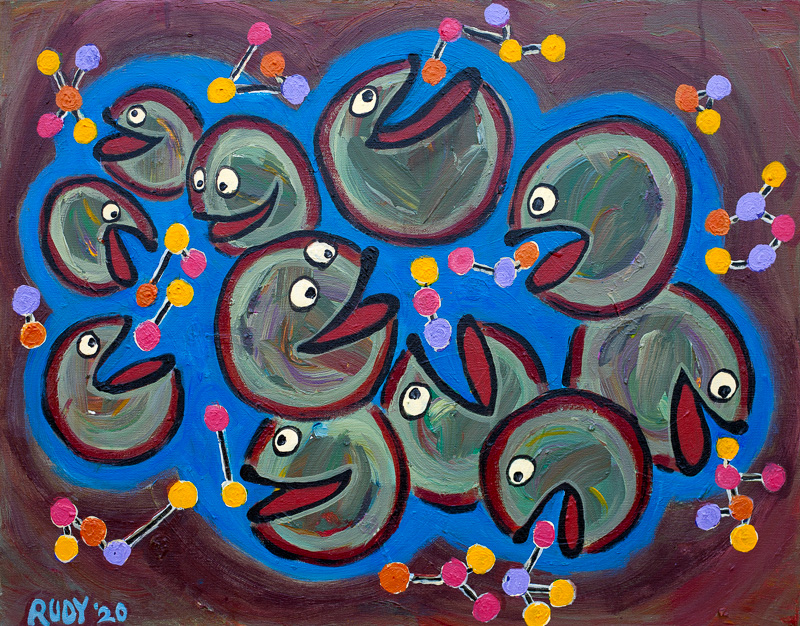
“Cells Eating Viruses” acrylic on canvas, May, 2020, 28” x 22”. Click for a larger version of the painting.
Biology is of course totally chaotic. And I had this vague, totally inaccurate notion of healthy blood cells killing off viruses by eating them in a chaotic battle—and I painted it. Cheerful round cells, and the viruses looking like stick-and-ball molecules. Nice colors, lively action, happy feeling. Almost like a Mardi Gras crowd! If only.

Gnarl and chaos very big in nature. Tulips are still alive for days after you put them in a vase, and they twine and bend and dance…chaotically, that is, unpredictably (in detail) but in certain natural “strange attractor” patterns (overall).
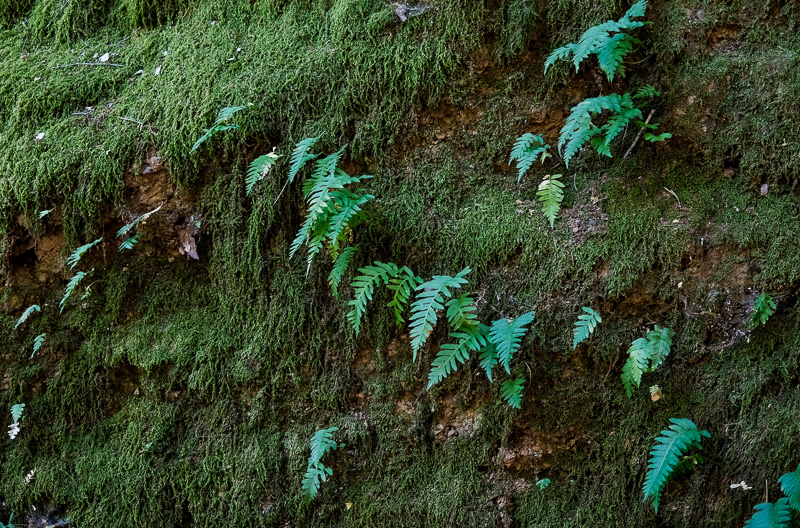
These ferns on a bank of moss are a kind of Poincare section of the temporal growth and dissemination of the plants across this little biome. A gnarly— and oh-so-gorgeous—freeze-frame of growth.
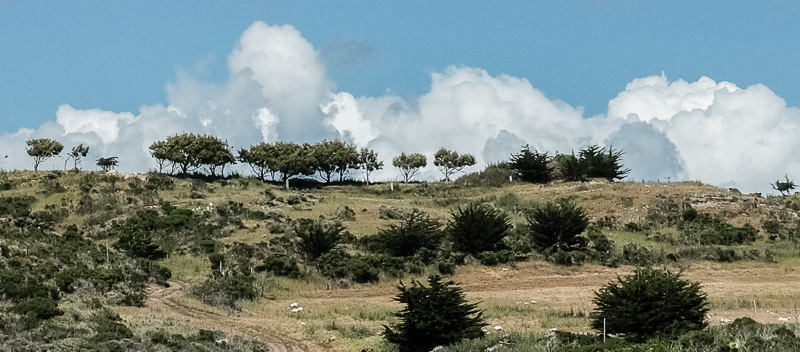
And how about this row of trees on a ridge. Chaotic process of geology for the ridge, chaotic growth for the arrangement of trees. For sure the cloud embodies a chaotic process. Shaped into a gnarly strange attractor.
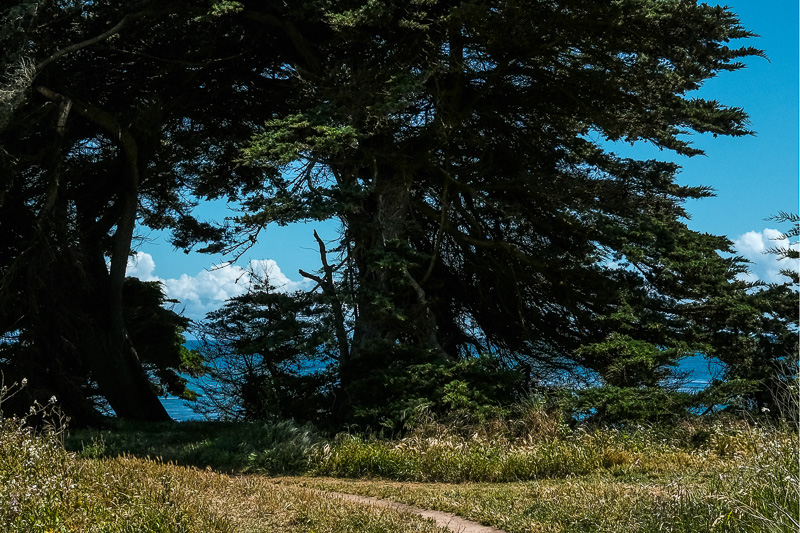
Being with the trees, the sea, the sky, it’s paradise. But you don’t always get to be there. Sometimes it helps to make things up.
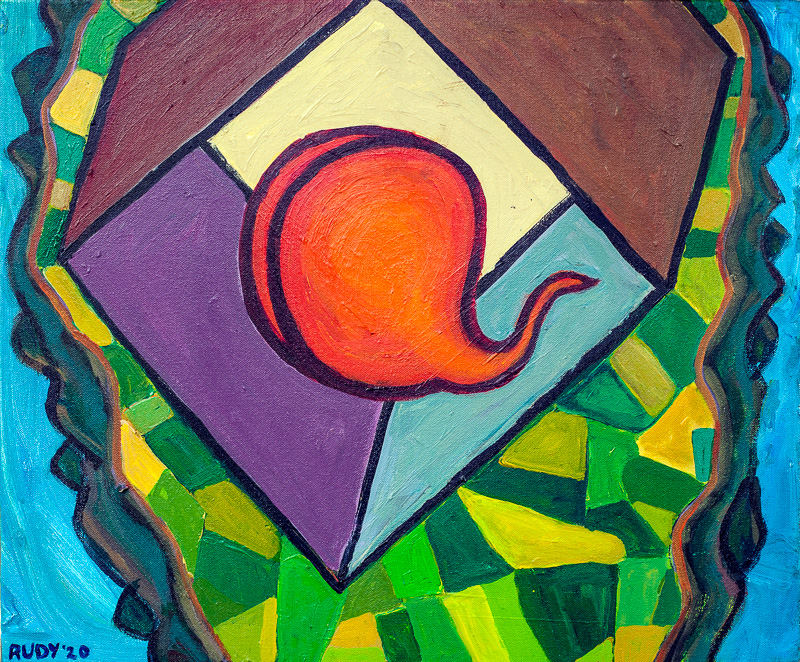
“Astral Travel” acrylic on canvas, May, 2920, 24” x 20”. Click for a larger version of the painting.
I painted this in the eighth week of quarantine in the pandemic of 2020. For an outing, my wife and I drove to Lick Observatory on nearby Mount Hamilton…and were barely allowed to get out of our car. I took in the uplifting view, and spotting a rusty iron chest set into the ground, I thought of my heart and mind and soul locked into the dull prison of shelter-in-place.

Driving home, we admired the bird’s eye view of the fields and mountains. And I thought of a brain in a cube, traveling. To make the painting fun, I put sky and mountain ranges on the both sides—with no clear notion of up and down—so that now we’re looking at an astral traveler who nears an agricultural asteroid. I had fun designing the quilt of fields; I tried to make each shade of green/yellow different.

Me now.

Me in 1965.
This week, my old friend Rob Lewine sent me this weathered photo of me at Swarthmore college. Unwashed hair, plump cheeks, eager smile. Happy to be loafing and drinking and having new friends and meeting women. Ah, youth. Everything so new. Not a care in the world.
It’s been a nice, gnarly, chaotic run. Thank you!









May 22nd, 2020 at 9:53 pm
Thanks for the great read.
May 23rd, 2020 at 5:26 am
What a wonderfull world we live in..thanjs for your illustrated glimps of mindthoughts..better to StayHi than to keep trying to Get High…and die trying..all Hail Chaos
May 24th, 2020 at 10:27 am
Of course we’re high. We be trippin’.
Ya wanna know how high? We’re so high, we think this is normal!
May 25th, 2020 at 4:17 pm
I loved those cells eating viruses. Nom, nom, nom!
June 5th, 2020 at 12:53 pm
I strongly believe that the date under the picture “Astral Travel” is not a typo! I think it’s really a picture from 2920 – a Poincare section of the 4-dimensional picture 😉